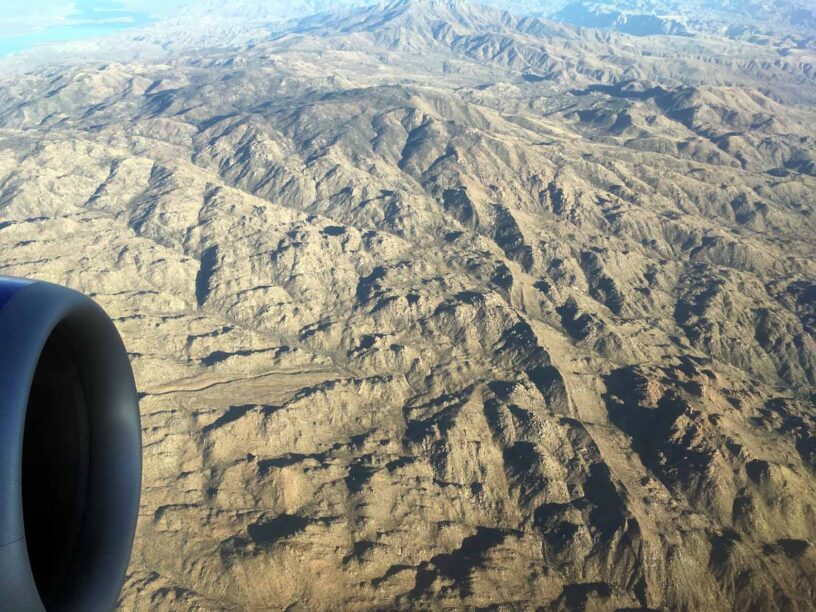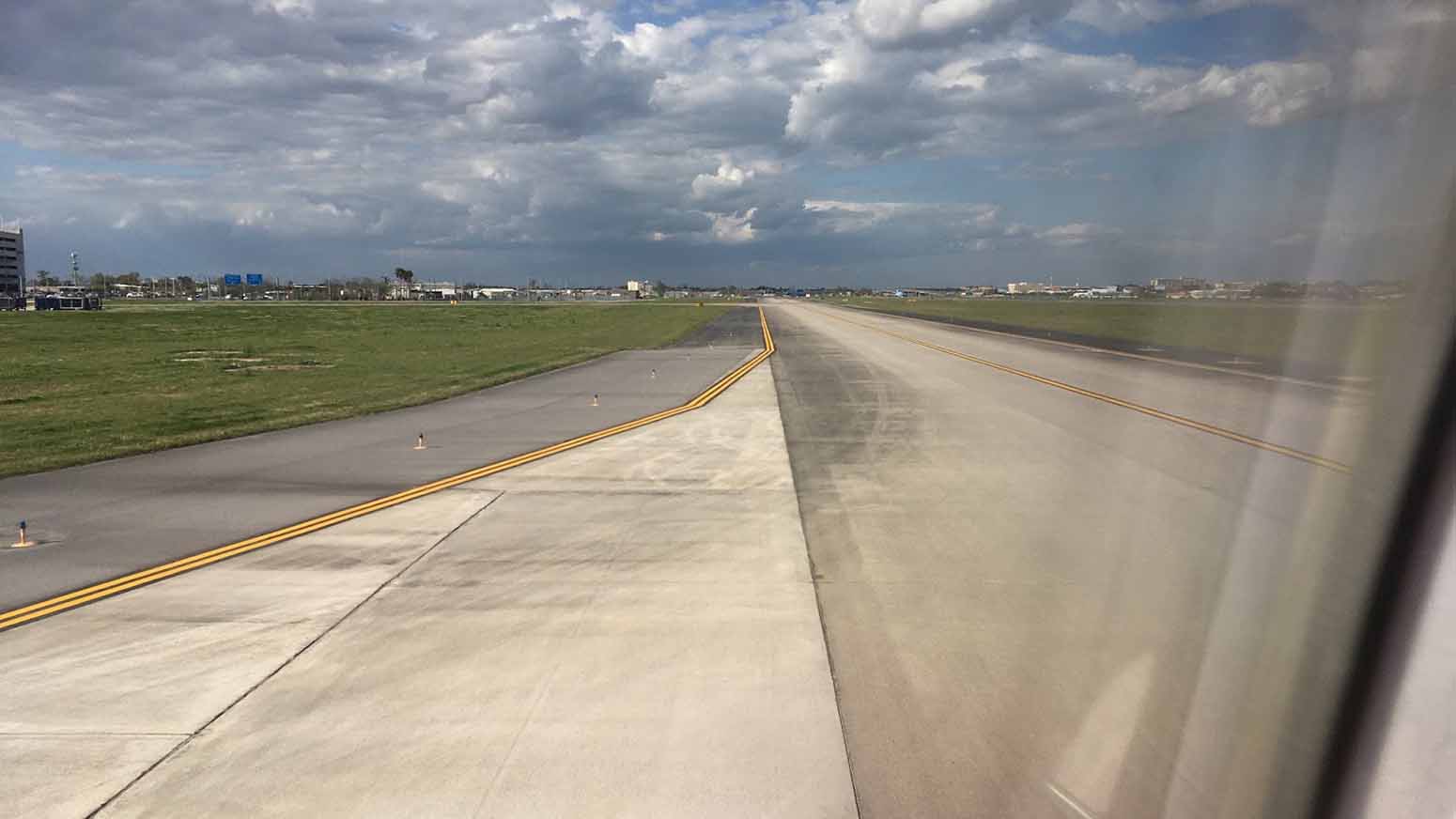WHEN MY BOEING 737-800 ascended above the scattered fluffy clouds—even with my row-mate coughing loudly into his mask a couple feet from my face—the view was as extraordinary as ever. We were soaring through the sky at five hundred miles per hour. This was it: the adventure I’d been promised in a United Airlines promotional email. I hadn’t flown in more than two years.
The new New Orleans airport has been both a smashing success and a profound disappointment. A disappointment because the pandemic jolted the new terminal almost immediately out of its resplendent launch, and thrust it instead into the pandemic dystopia of 2020, a global haze of heightened security, newly tweaked surveillance protocols, and evolving public safety measures as dictated by Covid-19. But even so, the airport won various awards during this time—Best mid-size airport in North America! Also #1 in Food & Beverage and Retail factor!
All these accolades feel empty now, when flying itself, a principal driver of the climate catastrophe, seems more superfluous than ever. Going there to fly, I am a planet killer.
When my sister and her family came to visit the week before, they’d waited for more than an hour for airport screening, so I got to the airport plenty early. I reached the front of the line in maybe ten minutes. And then, bizarrely, the TSA agent waved away my boarding pass when I tried to show it to her. She just scanned my passport and let me through. I suddenly felt like Tyler Durden, traveling smug, like it was 1999.
Most people wore their masks tight and over their noses, as instructed. But some drifted through the terminal with no masks at all; some wore their masks hanging at their chins; others held their masks in their hands, like flimsy flags waving at hip level. Over the loudspeakers, airport director Kevin Dolliole sternly announced that there would be severe fines and punishments for the unmasked; meanwhile people were traipsing around, maskless, mouth-breathing and unconcerned. It was a disorienting experience. From 9/11 onward, the overhead announcements at airports had been, if sometimes absurd, generally heeded. Everyone was committed to the safety of the airport—the safety of the public—right? Now that compact had somehow broken, replaced by a bizarre anything-goes attitude that permeated the seating areas, cafes, and restaurants.

Planes came and went; I sipped a glass of overpriced tempranillo and worked for a bit. Passengers filed in and out, I finished my wine, my flight was delayed by 30 minutes, I boarded smoothly and without incident. One fellow passenger wore a cool Mandalorian T-shirt: the rogue bounty hunter and his iconic Razor Crest starship, 737-like, in the background. Is this the way?
On the ascent, I felt the old feeling of sublime uplift and the majestic view of my city with the Mississippi River curling around it.
Greta Thunberg’s campaign for “Flygskam” or flight shame reflects an attitudinal change taking place. Environmental disasters—and our collective perception and awareness of them—are on the rise. Even when ecological catastrophes like wildfires and hurricanes appear to have little or no direct relation to air travel, they nevertheless become cumulative risk factors that may dissuade people from traveling as much—especially younger people for whom climate change is not an abstract concept, but daily life.
Though there are admirable efforts on behalf of aircraft and engine manufacturers to make aviation itself a “greener” industry, the carbon footprint of air travel is indisputable—especially at the scale with which we’ve come to expect it. The upcoming generation is poised to be rightly critical of air travel as a routine form of mobility. They’ve now seen it brought to a halt on a dime; and they have seen how it can be so easily replaced, too.
The romance of flying ended a long time ago. We’re just burning the same old contrails in the sky.
Somewhere over Texas, a flight attendant asked over the intercom if there were any medical personnel onboard. Five people jumped up and ran forward, one holding a stethoscope. Another requested a blood sugar monitor, an overhead signal beeped and soon a flight attendant was rushing back up the aisle with the small black pouch. No one checked their credentials or questioned the expertise of these medical professional passengers; it was a suspended moment of collective trust. When I have a medical emergency, whether on an airplane or on the ground, I want this exact spontaneous team by my side. (Actually I trust that this is the medical profession, at large.)
A few moments later, the distressed passenger was breathing from an oxygen tank and three of the five medics had gone back to their seats. The flight attendants were talking seriously into their crew phone. Would we have to make an unscheduled landing, to transfer this passenger to an ambulance? Anything could happen. It was an adventure, after all.
Five minutes later, the flight attendants were talking to one another and laughing. Things must be okay. Then, we seemed to be banking hard to the south. The seatmate of the sick passenger was moved to the row in front of mine, so that one of the medical professionals could stay with the sick passenger. My new neighbor’s mask read LET’S GO BRANDON. His laptop screen, visible between the seats in front of me, read: NEWSMAX. FOXNEWS. WHERESMYREFUND.IRS.GOV. This man was not the helper. I wasn’t the helper either, but then neither was I wearing a sign that said fuck the whole social order.
The plane banked back to the north. Maybe we’d still be going all the way to our destination? Actually we seemed to be zigzagging all over the place. Anything could happen. Anything already happened.
Hills, snowy ridge-lines, craggy peaks, strange circular depressions, river currents incredibly decipherable from 30,000 feet…it was sublime. On this very day of my first flight in over two years, my friend Jami Attenberg tweeted: “Ok very serious question here, if you’re a window person on an airplane, please explain to me why you like it. (I am, desperately, an aisle person.)” I replied immediately: “Landforms. That’s all!”

We are fragile bodies bustling through space and time, and there are real limits to our acceleration. Covid-19 was a blunt reminder of this; other reminders are sweltering on the ground and swirling in the seas.
Airports and airlines have been proven themselves to be anything but svelte or resilient. They are clunky, delicate, many-tentacled beasts. When they work, it’s a minor miracle—one we are so quick to take for granted. But maybe flight was a miracle that had its time. And it’s over; we just haven’t quite realized it yet.
But signs of flight’s demise are glaring around the terminal, as we plod through this latest travel season. Despite all the good reasons to mask up again, you certainly won’t be encouraged to do so at the airport. It’s astonishing, really: the place that held such sway in public consciousness as to what safety meant, has simply abandoned this role. It’s not so much that I always admired the TSA or that I reverently took off my shoes each time I passed through the checkpoint; but all security jokes aside, there was an ambient sense of solidarity at the airport. Not so, anymore.
I wrestle with this duality: Air travel as a way to connect with other people, share experience, and gain perspective, on the one hand—and on the other, commercial flight as the technical embodiment of mass solipsism. And even if I grant air travel the most generous reading as world-building, as connecting us socially—there are still the accumulating ecological tolls. The footprint of global air travel can’t be measured in discrete units of carbon spent, or offset. It’s a stranger, more fractal set of impacts.
When I get an invitation now to travel to a conference, I recoil. Maybe whatever I can do on Zoom is enough. Maybe it’s better, even—to just be present where I am. The adventure right in front of me: this is the way. The way to not kill a planet so forcibly, maybe even to perhaps aid in its long-shot recovery.
Christopher Schaberg is Dorothy Harrell Brown Distinguished Professor of English at Loyola University New Orleans, and the author of eight books. His new book, Adventure: An Argument for Limits, will be published by Bloomsbury in August 2023.
Thank you for reading POPULA! Add your email here to receive our newsletter!






